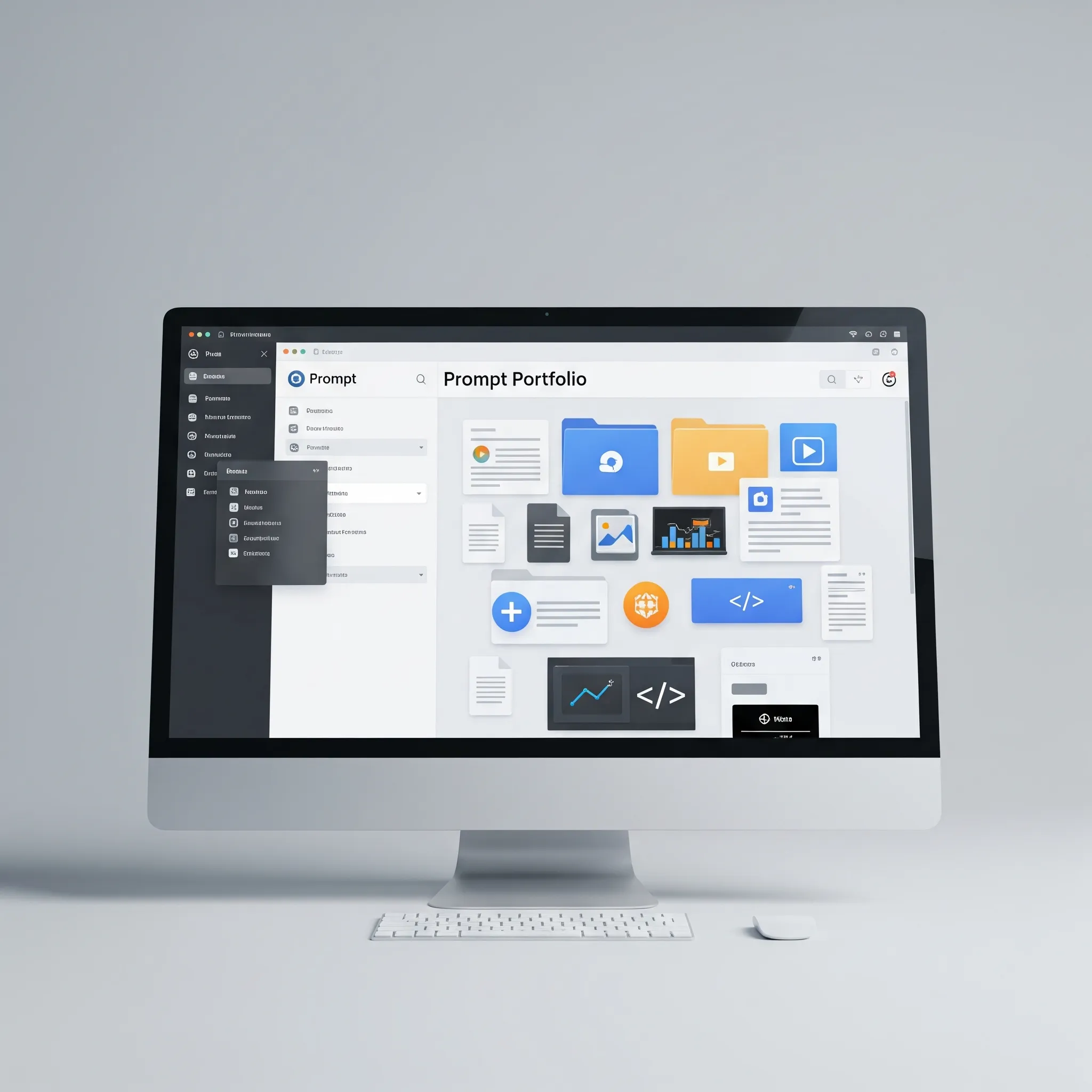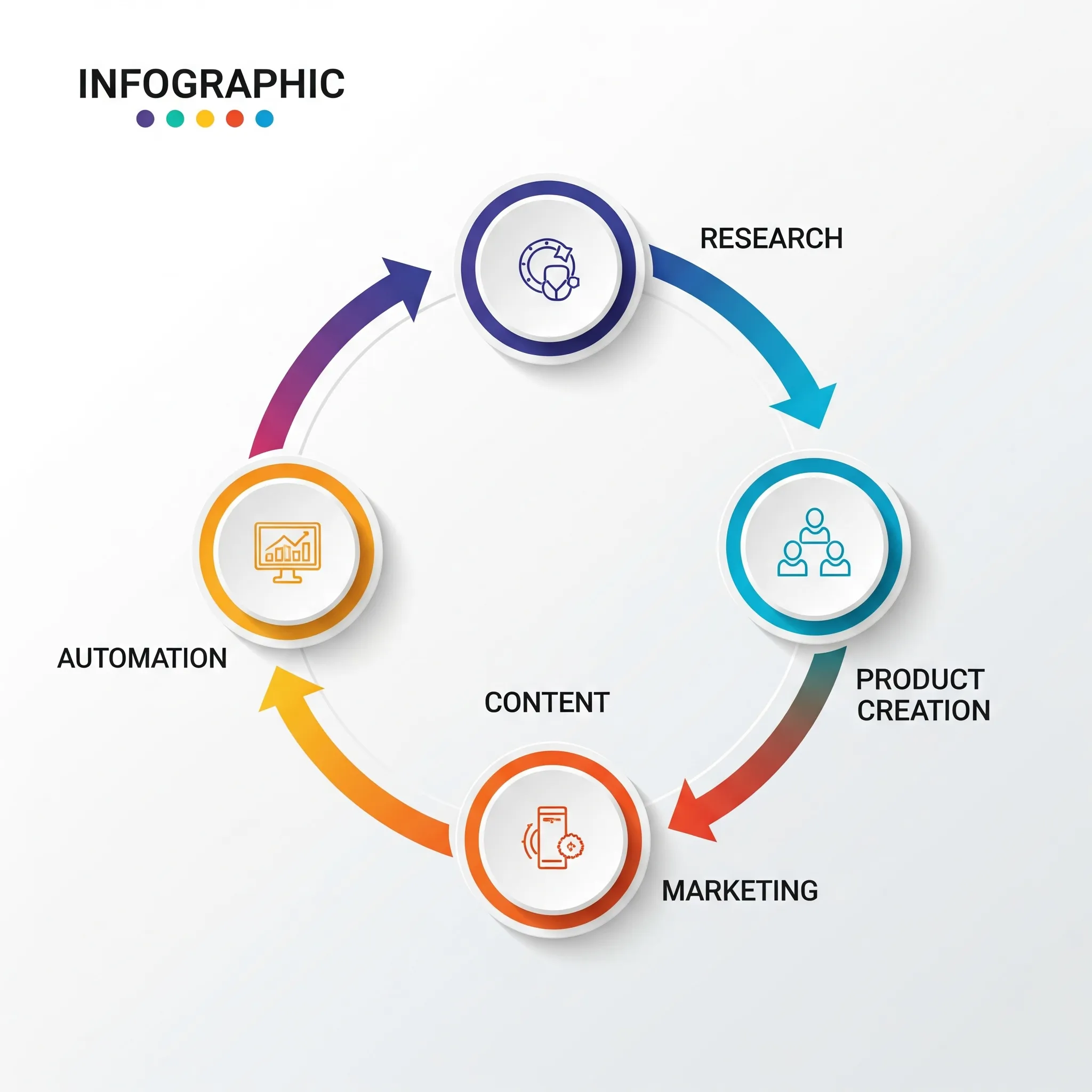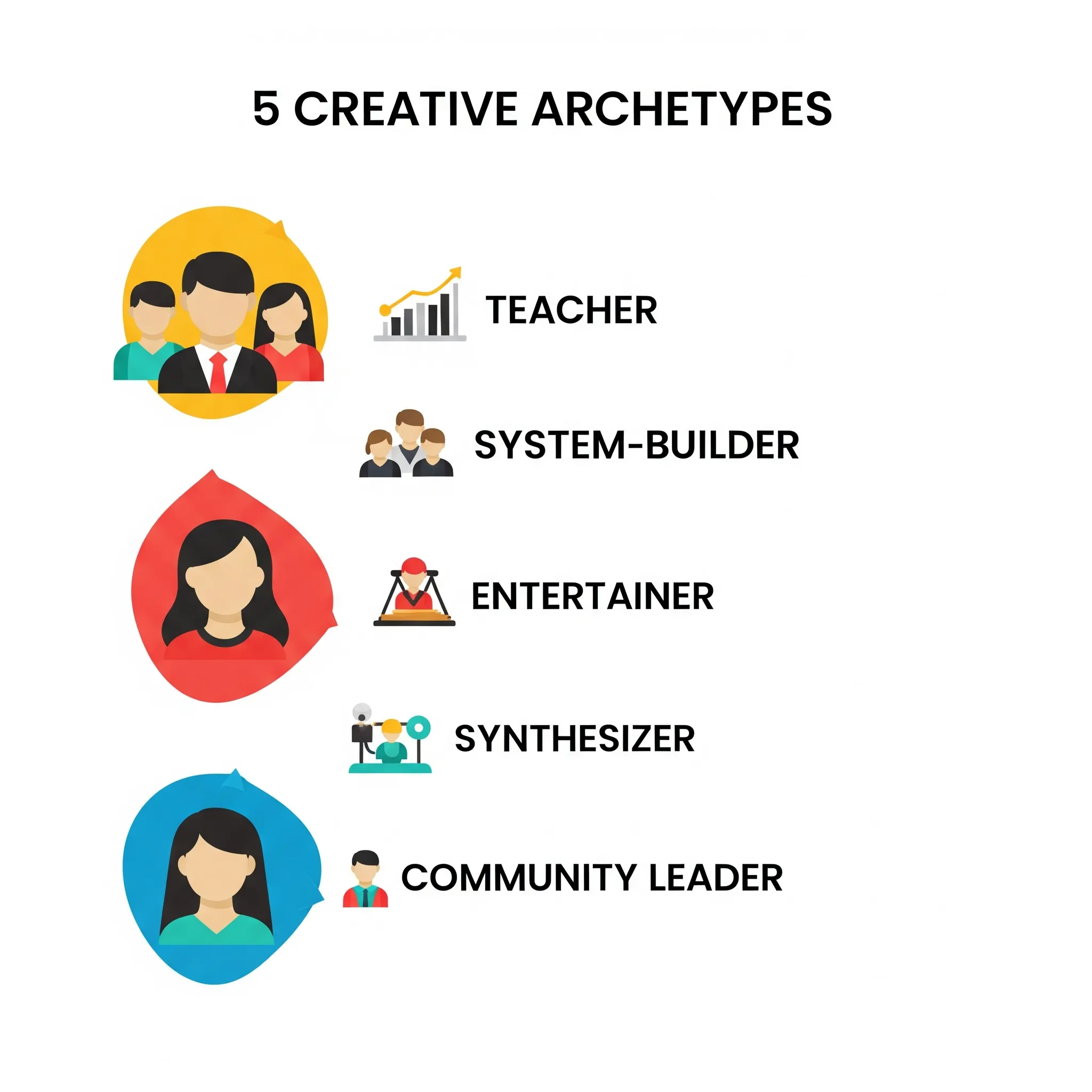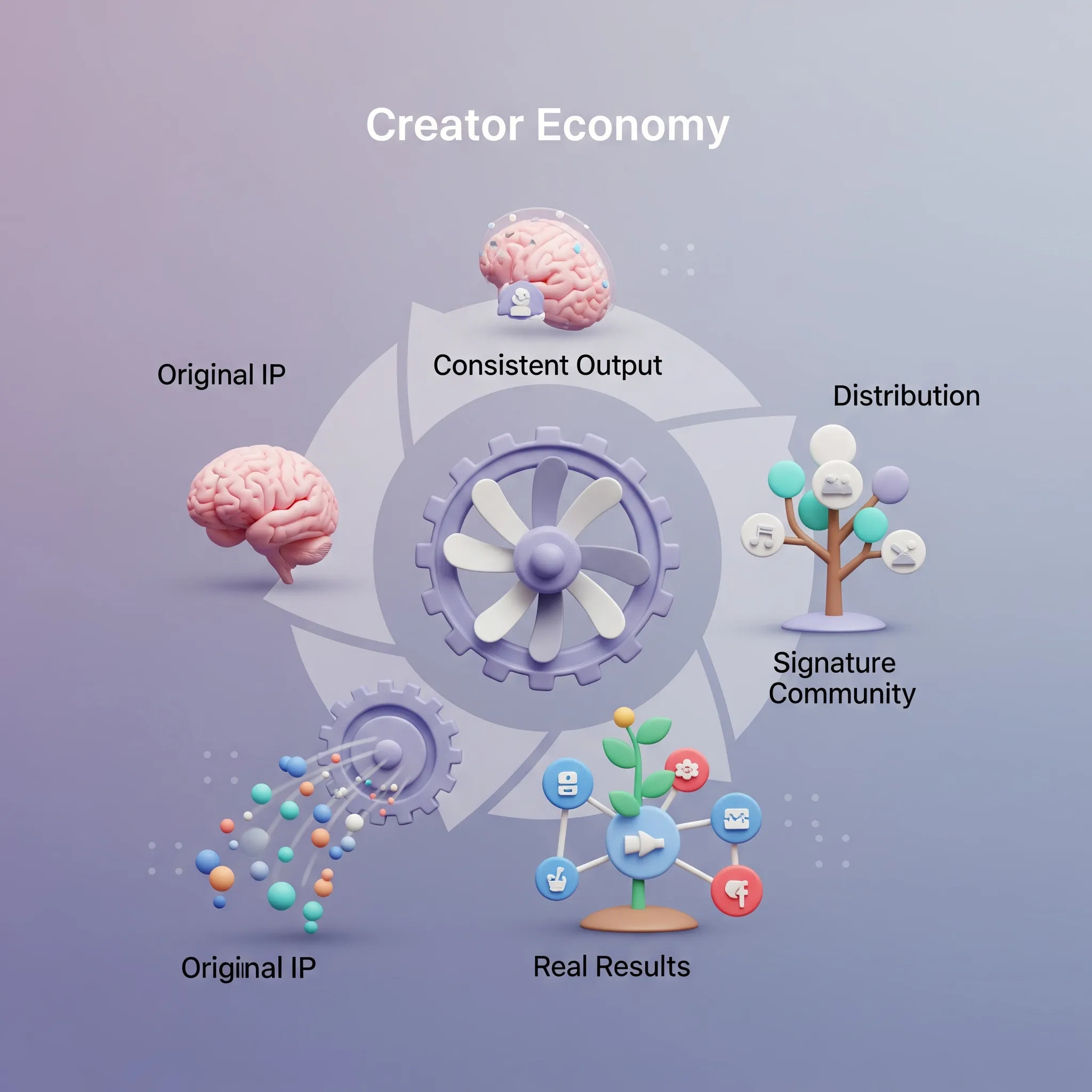Overview
-
Chapter 1: Hidden Strategies and Frameworks
-
Chapter 2: Counterintuitive and Under-Discussed Ideas
-
Chapter 3: Momentum, Leverage, and Scalable Creativity
-
Chapter 4: Monetization Models and IP for AI Creators
-
Chapter 5: Services and Productized Offers with AI
-
Chapter 6: Trust, Community, and Distribution in the AI Era
Chapter 1: Hidden Strategies and Frameworks
1.1 Prompt Portfolios as Digital Assets
Most creators treat prompts as disposable or one-time-use tools. But in reality, a well-designed prompt is a modular intellectual asset. When structured properly, a prompt can power a repeatable system that serves a variety of use cases.
Think of prompt portfolios like code libraries or design templates. A prompt isn’t just a sentence; it’s a reusable logic system. For example:

-
A prompt for writing Twitter threads on productivity can be adapted for newsletters, video scripts, or even course outlines.
-
A market research prompt can become a lead magnet that generates SEO-rich articles or product validation reports.
Key Insight: Bundle your best prompts into a branded system. Position it not as a prompt, but as a solution. Buyers don’t want prompts. They want outcomes—like content strategy, landing page copy, or brand positioning. Your prompts should speak that language.
Next Step: Organize prompts by outcome category, not tool type. Label them in your portfolio with results like “Validate a SaaS idea in 3 minutes” or “Write a 7-day email sequence from scratch.”
Creator Spotlight: Marie, a content strategist, turned her internal prompt templates into a $49/month membership. Her “Content Sprint Generator” helped solo founders write 30 days of posts in under 60 minutes. She now has 350+ subscribers.
1.2 The Prompt-Product Flywheel
This is a core framework to turn your prompting into an income-generating machine.
Here’s how it works:
-
Prompt for Research Use GPT to gather insights, pain points, questions, and keyword data around a niche or audience.
-
Prompt for Content Turn research into consistent value—articles, videos, tweets, newsletters.
-
Prompt for Product Creation Use AI to draft product outlines, module names, lessons, FAQs, or swipe files.
-
Prompt for Marketing Generate sales copy, email campaigns, CTAs, retargeting ad ideas, and YouTube titles.
-
Prompt for Automation Connect GPT outputs with tools like Zapier, Airtable, or Make to deliver products, answer inquiries, or even trigger upsells.

Key Mistake to Avoid: Using GPT to replace your thinking. The flywheel works only if you refine the outputs, interpret context, and understand your audience deeply. GPT is an accelerant, not a substitute.
1.3 The Productivity Stack for AI-Powered Creators
Time is your scarcest resource. The smartest creators today use GPT not just to write content but to architect systems that make them more valuable per hour.
Here’s an example productivity stack:

-
Capture: Draft tweets and notes inside Notion or Obsidian with GPT plugins.
-
Structure: Use GPT to sort your ideas by theme, format, and readiness.
-
Repurpose: Prompt GPT to turn long posts into scripts, carousels, reels, or threads.
-
Automate: Use Zapier to schedule posts or distribute content across platforms.
-
Measure: Use GPT to summarize performance analytics or extract insights from spreadsheets.
Bonus Layer: GPT can also function as your creative sparring partner. You can train it to ask you better questions than a blank page ever could.
Tool Tip: Try [Readwise + GPT Plugin] to surface your best highlights and turn them into new content formats weekly.
Chapter 2: Counterintuitive and Under-Discussed Ideas
2.1 Passive Doesn’t Mean Easy: Why AI Can Make It Harder
Many creators enter the AI space believing it’s a shortcut to passive income. In truth, GPT removes friction from execution but increases the cost of bad strategy.
Here’s why:
-
When it’s easier to create, you create too much of the wrong thing.
-
You dilute your message by generating without direction.
-
You optimize outputs but ignore the core question: Is this worth making at all?
Counterintuitive Truth: GPT raises the bar. It saturates markets with average. The new differentiator is taste, judgment, and positioning.
Passive income still requires active design thinking—systems, validation, user testing, and brand clarity. GPT gives you leverage, not guarantees.

Ethics Note: More speed doesn’t excuse poor value. Use AI responsibly: validate your products with real users, not just AI simulations.
2.2 The Danger of Prompt Dependency
Prompt engineering is a superpower, but it can also become a crutch. Many creators unknowingly lose their voice, originality, and critical thinking when they lean too heavily on AI.

Signs of prompt dependency:
-
Your content sounds generic or overly structured.
-
You forget how to write cold, without GPT.
-
You second-guess your own ideas and need AI to validate everything.
What to Do Instead:
-
Alternate between “solo drafts” and “AI-enhanced drafts.”
-
Use AI as a research assistant and editor, not your first brain.
-
Run a weekly “no-AI” challenge to keep your creative instincts sharp.
Key Idea: GPT should amplify your voice, not replace it.
Weekly Practice: Spend 1 hour creating content with no AI assistance. Compare the result. Reflect on what you missed—or regained.
2.3 The Creator-Prompt Fit Model
Not all creators benefit from GPT in the same way. Here’s a model to match your content style to the most effective use of prompts:
| Archetype | Strength | GPT Use Case |
|---|---|---|
| The Teacher | Explaining clearly | Clarify, simplify, use analogies |
| The System-Builder | Organizing processes | Build templates, dashboards, checklists |
| The Entertainer | Engaging audiences | Hooks, storytelling, satire |
| The Synthesizer | Connecting ideas | Mashups, analysis, contrarian takes |
| The Community Leader | Building trust | Polls, onboarding, conversation starters |
Key Insight: Use your natural creative archetype to determine which GPT use cases bring you energy. Avoid prompt styles that drain or distract you—even if they’re trending.
Note: This is your creative alignment, not a constraint. You can evolve.

2.4 The Myth of Infinite Niches
One of the most seductive promises of AI is that you can spin up content in any niche instantly. While technically true, this can lead to surface-level execution and audience confusion.
Here’s the trap:
-
GPT makes it easy to create, but niche mastery still requires lived experience.
-
Jumping into unfamiliar spaces may generate short-term clicks, but not long-term trust.
-
Being “multi-niche” often means being forgettable.
Better Approach: Pick a core niche where you have credibility, then explore adjacent topics through the lens of your expertise. Use GPT to expand laterally, not randomly.
Example: Instead of switching from “solopreneurship” to “AI in real estate,” try: “How solopreneurs can use GPT to validate service-based business ideas.”
Prompt Practice:
“List 10 topics adjacent to [my niche] that my audience would care about, and suggest how I can frame them with my current brand voice.”
2.5 When to Build a Bot, Not a Brand
Everyone talks about personal branding—but some creators may benefit more from building a tool, not a persona.
AI lets you productize your thinking without making yourself the centerpiece. In some cases, this is a better strategy:
-
You want to stay anonymous or avoid being the face of the brand.
-
You’re better at systems than storytelling.
-
You want to sell a solution, not a philosophy.
Example Approaches:
-
Package your prompts into a no-code GPT app or chatbot.
-
Sell a niche “mini-SaaS” using GPT behind the scenes.
-
Create a white-label prompt system for agencies or consultants.
Key Insight: You don’t need 10,000 followers if your prompt engine solves a $1,000/month problem for a niche audience.
2.6 AI as a Mirror, Not a Muse
One overlooked use of GPT is introspection. GPT can be used not just to generate content, but to reflect your own thinking back to you.
Use it to:
-
Spot inconsistencies in your content strategy.
-
Summarize your own writing and surface themes you weren’t aware of.
-
Ask you questions that clarify your priorities, fears, or blind spots.
Prompt Practice:
“Based on the last 5 pieces of content I wrote, what seems to matter most to me—and what might I be avoiding?”
This transforms GPT from a content machine into a creative mirror. It helps you write from alignment, not just efficiency.
Try This Weekly: Feed GPT your latest newsletter or posts and ask, “What values am I signaling here?” Use the answer to refine your positioning.
Chapter 3: Momentum, Leverage, and Scalable Creativity
3.1 The Compound Leverage of Small Prompt Systems
In the world of AI-enhanced creation, you don’t need a huge team or a long runway. What you need is stacked leverage—small prompt systems that feed each other.

Think of each prompt system as a flywheel component:
-
A newsletter outline generator fuels weekly publishing.
-
A course idea validator powers new digital product launches.
-
A cold-DM prompt improves conversions and fuels audience growth.
The trick is to connect them, not keep them siloed. One small system builds on the next.
Example: Your “Audience Pain Point Extractor” prompt feeds into a “Content Pillar Builder,” which then powers your “Content to Product Converter.” Together, they form a living system that learns and grows with you.
Prompt Stack Exercise:
“List all the micro-prompts I use weekly, and map how they feed into one another. Where are the bottlenecks or missed handoffs?”
3.2 Build Backwards from Proof, Not Vision
Traditional creators often build from vision—what they want to create. Smart AI creators flip this. They build from proof.
Proof = what people already respond to.
-
Look at the posts or prompts that sparked DMs or saved replies.
-
Review which GPT outputs made you say “Damn, that’s good.”
-
Watch what others steal, remix, or rephrase from you.

AI lets you pressure test fast. Use GPT to remix your top-performing ideas in different formats and voices. Don’t create until you see clear signals.
Prompt to Try: “Take my top 5 LinkedIn posts and identify what tone, structure, or idea style made them perform best. Suggest 5 similar ideas with a twist.”
This strategy compounds insight. Vision is great—but proof funds it.
3.3 Create ‘Distribution-First’ Prompts
We often design prompts for content. But the better model is to design prompts for distribution.
Instead of just asking GPT to “write a blog post,” try this layered sequence:
-
“Summarize this blog post into a viral tweet.”
-
“Turn this tweet into a quote graphic for Instagram.”
-
“Write a reply to this tweet that invites DMs or list signups.”
-
“Draft a carousel using the key points, optimized for LinkedIn formatting.”

Each piece of content should have an exit ramp—a prompt-driven path to keep the reader moving toward deeper engagement.
Power Move: Build a prompt template that auto-generates multi-format content from one source post. This becomes your distribution engine.
3.4 From Prompt Tinkerer to Prompt Architect
Most creators stay at the “prompt tinkerer” stage—typing into GPT and hoping for something useful.
To level up, you need to become a Prompt Architect—someone who builds reusable, modular, interoperable prompt systems.

Key traits of a Prompt Architect:
-
Thinks in systems, not sessions.
-
Designs prompts that can be reused by clients, teams, or customers.
-
Stores prompts with version control and clear naming conventions.
-
Writes prompts that output in structured formats (e.g., JSON, Markdown, Airtable-ready).
Starter Tip: Add metadata to every prompt you save:
-
Goal
-
Target audience
-
Input format
-
Output format
-
Ideal tone
Prompt: “Create a prompt documentation template for my prompt library so it’s easy to reuse and improve across my team or products.”
This is how you move from user to creator of AI infrastructure.
Chapter 4: Monetization Models and IP for AI Creators
4.1 From Prompts to Products: Packaging Your IP
The first step to monetization isn’t to sell prompts—it’s to productize the result your prompts enable. You’re not selling inputs. You’re selling transformations.
Bad Offer: “50 ChatGPT prompts for course creators” Good Offer: “Create your full course outline, sales copy, and email sequence in 24 hours with my AI-powered system.”
Ways to Package Prompt-Based IP:
-
Templates: Branded prompt workflows in Notion, Airtable, or PDF.
-
Mini-Products: Niche, outcome-driven tools like “The AI Resume Builder” or “Startup Pitch Deck Generator.”
-
Memberships: Ongoing access to updated prompt systems, content, and private communities.
-
Toolkits: Bundled playbooks, prompt packs, and video walkthroughs tailored to a niche.
Monetization Mindset:
Don’t just share prompts—build systems with proof. Include before/after results, use-case examples, and walkthroughs. That’s what makes the value tangible.

4.2 Layered Pricing: Turn Your Prompt System into a Value Ladder
Not all buyers want the same level of help. Use AI to create layered offers at different price points.
The Prompt Value Ladder:
-
Free: Lead magnet prompt (e.g. “Get 3 AI prompts to generate newsletter ideas in 2 minutes”)
-
Low-Ticket: \(7–\)49 toolkits or single-use templates.
-
Mid-Ticket: \(99–\)499 guided systems, mini-courses, prompt vaults.
-
High-Ticket: $1k+ for cohort-based courses, private consulting, or white-label prompt systems.
-
Recurring: Subscriptions or retainers (prompt updates, custom GPT agents, ongoing prompt tuning)

Example: A creator sells a $27 “Content Generator” template → upgrades customers to a $297 Prompt System Bootcamp → offers $1200/month custom AI strategy for teams.
AI helps you create every tier faster—but strategy determines the revenue.
4.3 Sell Outcomes, Not Access
AI commodifies tools. What people still pay for? Confidence and speed to results.
Frame your offer around the transformation, not the tech:
-
“Save 10 hours a week repurposing content across 3 platforms.”
-
“Land 5 podcast guest spots in the next 30 days using our AI pitch kit.”
-
“Validate your SaaS idea in under 15 minutes with our prompt system.”

This is where most prompt creators lose momentum: they sell tools instead of selling certainty.
Audit Prompt: “Rewrite my product description to focus on outcomes, proof, and specificity—not features.”
Pro Tip: Add before-after-bridge copy to every offer page:
“Before: You’re stuck staring at a blank page. After: You publish a 7-email sequence in 20 minutes.”
4.4 Protect and License Your Prompt IP
As your systems grow in sophistication, so does their value. Treat them like assets.
Tactics to Protect and Scale Your Prompt IP:
-
License Your Systems: Let agencies or creators use your prompts in client work for a fee.
-
White-Label Deals: Sell your prompt workflows under someone else’s brand.
-
Use Legal Wrappers: Add Terms of Use, licenses, and attribution policies to your prompt bundles.
-
Version Control: Track and iterate on prompt updates like software. Your v2.0 prompt can outperform and upsell your v1.0 users.

Prompt to Try: “Write a plain-English license agreement for users of my AI prompt pack, including allowed and prohibited uses.”
Mindset Shift: You’re not just a content creator. You’re a system builder. Protect your leverage.
Chapter 5: Services and Productized Offers with AI
5.1 Turning AI Skills into Services
You don’t need to launch a product to monetize AI. Service-based creators—freelancers, consultants, agencies—can immediately turn GPT into a force multiplier.
Here’s how AI-augmented services play out in the real world:
| Traditional Service | AI-Powered Upgrade |
|---|---|
| Copywriting | AI-first frameworks, SEO content in bulk, email swipes generated in minutes |
| Market Research | GPT-driven analysis from Reddit, Amazon reviews, competitor sites |
| Branding | Generate name options, taglines, messaging pillars instantly |
| Coaching | Use GPT to summarize calls, generate action plans, prep pre-call diagnostics |
| VA/Admin Work | Auto-generate reports, emails, summaries, SOPs via prompt systems |
| Positioning Tip: Frame GPT as your edge—not your replacement. You’re not selling robot outputs. You’re selling faster outcomes at lower cost with the same (or better) quality. |

5.2 Productized AI Services: The New Consulting
Done-for-you work scales poorly unless it’s repeatable. With AI, you can standardize your creative process and sell it as a productized service.

Examples of Productized AI Offers:
“Get a full content calendar, post templates, and AI scripts for $349.”
“Audit your website and rewrite 5 high-converting pages using my AI system—$497 flat.”
“Turn your 60-minute podcast into a blog, newsletter, and 12 social clips—delivered in 72 hours.”
Framework to Build Your Offer:
-
Outcome: What is the client getting?
-
Process: How do you use AI to make it fast + repeatable?
-
Positioning: Why does this system work better than traditional freelance work?
Key Insight: A great productized offer is clear, outcome-driven, and process-backed.
5.3 Custom GPT Agents as a Service
The fastest-growing demand in 2025? Custom GPT agents built for niche business tasks.
You can now build and deploy GPT-4 agents with custom instructions, memory, file uploads, and API access—no coding required. This means:
-
An interior designer gets a “Room Stylist GPT” to help clients visualize design ideas.
-
A coach gets a “Mindset GPT” trained on their frameworks and tone.
-
A course creator gets a “Course Assistant GPT” that answers student questions 24/7.

How to Monetize:
-
Build one-off agents for a flat fee (\(500–\)2,500).
-
Offer setup + maintenance retainers (\(300–\)1,000/month).
-
Bundle your GPT into your client packages (e.g. “every client gets their own trained AI assistant”).
Prompt to Try: “Design a GPT agent for [industry] that solves [pain point] using [my system or IP]. Suggest monetization ideas.”
Pro Tip: Include a usage guide or onboarding video. Many clients don’t know how to get value from GPT—help them unlock it.
5.4 Service Creators as System Architects
In the AI era, you're no longer just the executor. You're the architect of workflows powered by human + machine collaboration.

What this means:
-
You use GPT to standardize your knowledge into systems.
-
You sell the outcome, powered by AI but delivered with your strategic insight.
-
You build assets—SOPs, templates, prompt flows—that are repeatable and sellable.
Example: A UX consultant turns their discovery process into a semi-automated GPT system that interviews clients, surfaces pain points, and drafts user stories—delivered as a productized offer.
Key Shift: You’re not building prompts. You’re building repeatable transformation machines—with AI as your co-pilot.
Chapter 6: Trust, Community, and Distribution in the AI Era
6.1 AI Has Changed What People Trust
In a world where content is easier and faster to produce than ever, what people trust has shifted:
-
They don’t trust volume—they trust voice.
-
They don’t trust perfect—they trust personality.
-
They don’t trust content—they trust context and consistency.
The paradox of AI is this: as outputs become easier, trust becomes harder.

What This Means for Creators:
-
Be visibly human. Show your process, opinions, even your uncertainty.
-
Be selective. Curate more than you generate. Signal taste over scale.
-
Be real-time. Respond to your audience’s world, not just your content calendar.
Key Insight: Audiences now look for “signal amplifiers”—creators who help them think, not just consume.
6.2 The Rise of Micro-Communities
With AI automating broad, generic content, community becomes your real moat.
People don’t want just more information. They want interpretation, belonging, and direct access to aligned people.

Tactics to Build Community in the AI Age:
-
Turn lurkers into members. Add CTAs like “DM me ‘JOIN’ to get my private vault.”
-
Create shared rituals. Weekly challenges, live critiques, open office hours—these build loyalty.
-
Blend AI with people. Offer GPT-powered tools plus group coaching, co-working, or events.
Example: A course creator offers a “Content Assistant GPT” alongside a monthly workshop where users share outputs and get feedback.
Pro Move: Let your AI create the value, but let your community create the stickiness.
6.3 Thought Leadership Is Now About Curation
The best creators today aren’t the ones who publish the most—they’re the ones who filter the noise and shape meaning.
Your job isn’t just to create content. It’s to make your audience smarter, faster.

3-Part Curation Stack:
-
Source – Use GPT to monitor trends, pull highlights from books, extract ideas from conversations.
-
Sift – Ask GPT to summarize, rank, and categorize. Add your own take.
-
Share – Deliver insights in voice-driven formats (emails, looms, memos, swipe files).
Tip: Curation isn’t passive. It's sense-making. That’s the new value.
Prompt to Try: “Summarize the top 3 frameworks from this 20-page PDF. Add 2 contrarian points and a 1-line hot take I can use in a tweet.”
6.4 Ethical Distribution in an Automated World
AI makes it easy to post 100 pieces of content a day. But does that build your brand—or dilute it?
The New Rule of Distribution: Less spam, more signals.

-
Choose fewer platforms, but go deeper with audience interaction.
-
Use GPT to optimize headlines, but write intros and CTAs with intention.
-
Use automated repurposing, but audit for tone and trust.
Quality → Relevance → Resonance. Don’t just be seen. Be felt.
Test: If your post went viral without your name on it, would people still know it was you?
6.5 Building a Reputation Loop
You don’t need millions of followers. You need recognition in the right circles.
Here’s how the best AI-first creators build reputation:

-
Original IP – Your unique frameworks, visuals, or language models.
-
Consistent Output – Systems to publish regularly, even in small doses.
-
Results Screenshots – Real-world outcomes your AI systems helped produce.
-
Signature Community – A branded Discord, newsletter, or learning hub.
-
Distribution Flywheel – GPT helps you turn one win into 10 formats and 100 impressions.
Key Insight: GPT gives you reach. Community gives you roots.
Try This: Pick one piece of feedback from a client or community member. Turn it into a post, a case study, a testimonial, and a lesson for your next offer.
#AI #Money